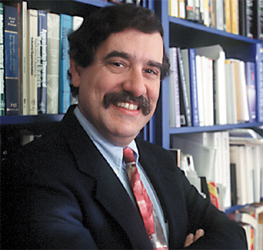
|
{
C O N T E N T S } Download Newsletter pdf |
|
ISCB Board of Director Introduces Newly Elected Executive Committee Officers The ISCB
Board of Directors is pleased to introduce the newly elected Officers
who will serve as the senior leadership of the Board on the Society’s
Executive Committee (EC) for the next two years. Of course, these
introductions are not really new, as all four of these individuals
have served on the EC this past year. But their election to a second
term, and Michael Gribskov’s rise from Vice President to President,
is worthy of celebration for the membership of ISCB, indicating
a strong vote of confidence based on successful new initiatives
and developments over the past 12 months.
An ISCB member
since 1997, Michael Gribskov has served on the Board of Directors
and conferences committee since 1999, becoming co-chair in 2000.
Since then, he also took on co-chairmanship of the education committee
in 2002, and became ISCB Vice President that same year.
When asked about important issues facing the ISCB in the years ahead, Tramontano said, “I think that the work started with the Affiliated Regional Groups should go further and be pursued more proactively. We have collected information on several new and forming groups, and the next step should be to convince these groups, many of which are still rather unstructured, to contribute more effectively to the life of the Society for the betterment of the science beyond their individual regions.” As she heads the Affiliated Regional Group effort, it is expected to see excellent progress in this area. Tramontano also feels very strongly that the structure of the Society, especially with respect to its committees, needs some rethinking. “The role of each committee should be regularly reevaluated,” she said. “There should be a mechanism in place to allow all interested and willing members to contribute to them.” Several members of the Board and many individual ISCB members have repeated these sentiments, and the Society’s staff is working now with committee chairs to put the wheels in motion for more purposeful and better functioning committee structures. From a personal perspective, Tramontano would like to help ISCB try harder to have an impact on European funding in bioinformatics. “As for Europe, I started to discuss the issue of a possible cooperation between ISCB and EMBO, with promising preliminary results.” At the same time, and although she acknowledges it may be more difficult than on other continents, Tramontano encourages the ISCB to take advantage of existing European federations of societies and try to lobby with them, just as has recently begun within the USA by becoming an associate member of FASEB. CONTACT: Anna.Tramontano@uniroma1.it
David Rocke
has spent 25 years teaching statistics and management science at
the University of California, Davis(UCD). Through teaching, seminars,
and some formal course work, he acquired a working knowledge of
the basic business disciplines, including finance, accounting, and
management information systems. He currently manages a research
center with a three million budget in the College of Engineering
and the School of Medicine at UCD. Rocke has also served as ISCB
Treasurer for one year, becoming familiar with the financial issues
facing the Society, and ready to continue his efforts for this next
two year term.
Bryant sees major issues facing the ISCB as continuing to improve the quality of the Society-associated journals, conferences, and education at the intersection of life sciences and computation, taking advantage of opportunities to influence governments throughout the world, and determining and acting on our responsibilities as scientists and engineers to society as a whole. Although not intending to accomplish this alone, she embraces her role as ISCB Secretary as one involving communication on behalf of the Society, both within the Board of Directors and through membership outreach. Additionally, Bryant has taken a first step in the issue of funding by becoming the ISCB representative to the Federation of American Societies for Experimental Biology (FASEB) Board of Directors and Public Affairs Committee. She believes the broad funding effort can be further augmented by ISCB’s active recruitment of non-U.S. members into the society, onto the Board of Directors, and onto the Executive Committee to help “identify means of influencing and informing governments and public decision-makers outside of the United States.” Bryant further points out, “In the United States and elsewhere, government research funds are shifting to defense against bioterrorism. How does this change affect our field? ISCB should be a voice advocating responsible allocation of funds across scientific endeavors.” One of many solutions she suggests is that the Society create forums for Members to discuss and formulate recommendations that can be taken to policy makers by the newly formed ISCB Government Relations Committee. Like ISCB Vice President Tramontano, Bryant advocates active and functional Education, Conferences, Publications and Government Relations Committees that involve more Society members in their discussion and recommendation processes. Specifically, she would like to see the Education Committee pursue opportunities currently under discussion to create resources for educational institutions and students. Finally, Bryant is an advocate for appropriate public access to code, data and scientific analyses (literature), and would like the ISCB to provide information and support for researchers who wish to share their work. She encourages the Society to investigate legal issues relating to Intellectual Property and make recommendations to lawmakers and institutions for solutions that benefit the advancement of knowledge. On a lighter note, Bryant promises “to continue my campaign to make Orienteering the official sport of the Society!” And if you know anything about Orienteering, all of the above is comparable to one big course, with each of the Officers, Directors, and Society members participating in reaching the final destination with the tasks of greatest value completed. An important element of Orienteering is that the participants have fun, so the ISCB Board of Directors encourages each and every member to fully enjoy the features and benefits of membership, while gaining valuable support and resources in the process. CONTACT: Barb.Bryant@mpi.com |




